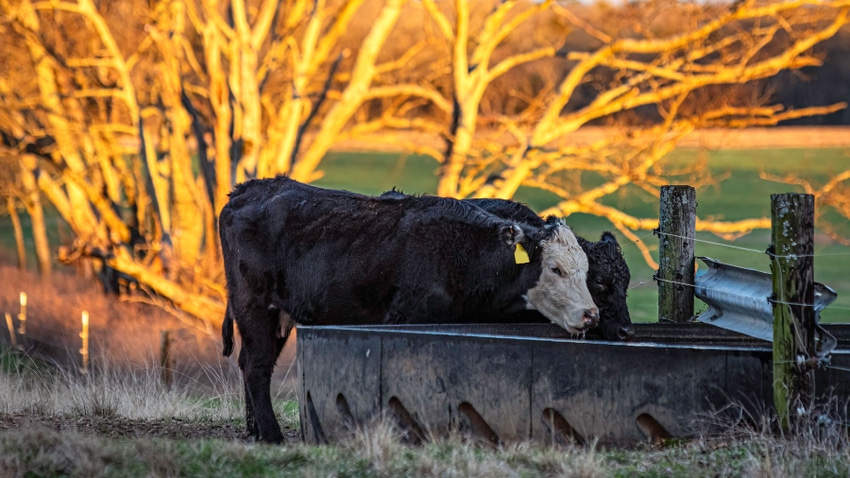February 6, 2024

At a Glance
- Water is vital for growth, reproduction, lactation and the regulation of body temperature.
- Cattle often increase their water consumption in colder weather.
- Make sure heated waterers are not getting too hot.
by Kate Hornyak
Water stands as an essential nutrient for beef cattle, much like it does for humans. It plays a vital role in various bodily functions, including growth, reproduction, lactation and the regulation of body temperature.
However, the winter season intensifies the challenge of providing a sufficient and accessible water supply. This difficulty is compounded by the freezing temperatures and changes in the behavior of the livestock during colder months.
Winter water challenges
Managing water for livestock during the winter months presents distinct hurdles. The primary issue is the freezing of water sources, limiting cattle's access to water. Cattle often increase their water consumption in colder weather to meet their heightened energy needs. This requires more focused management strategies to ensure they receive sufficient hydration.
In colder temperatures, cattle consume more feed to maintain body heat. If water availability decreases, feed intake also drops, leading to poorer body condition. This is particularly critical if the birthing season is in spring, as reduced water and feed intake during winter can lead to poor fetal growth rates and lower lactation levels.
Methods to deliver water
Having electricity at your winter-feeding areas is a huge plus. It unlocks several effective methods to prevent your cattle's water supply from turning into an icy hazard.
A straightforward solution is to use a plug-in heater, which can be installed in the drain plug of a large stock tank. This approach is simple and efficient, ensuring that water remains in a liquid state for your herd.
Large stock tanks with larger capacity are another option that can be considered. Stock tanks need to be checked often to allow livestock access to water and ensure filling purposes. Opting for ones with a larger capacity can make a difference when temperatures drop.
To combat ice formation, consider installing a continuous flow valve. This valve will prevent freezing and ice from accumulating in the tank.
In areas where electricity isn't an option, natural sources such as ponds and springs come into play for livestock hydration. However, during winter, these natural waterways can present challenges, especially on extremely cold days when freezing is a concern.
To navigate this, one can employ innovative methods such as a collection trench combined with solar-heated devices. These systems often include heat tubes buried deep underground, capturing solar energy to prevent water from freezing.
However, it's important to note that even with these measures, on particularly frigid days, with frequent visits by the herd to the water source, a thin layer of ice may still form. In such instances, breaking the ice becomes necessary to maintain uninterrupted access to water for your livestock.
What is ideal
Keeping the ideal temperature of drinking water for cattle is a balance — it should neither be hot nor frozen. The sweet spot lies between 40 and 65 degrees F. It's interesting to note that steers with access to cool drinking water have shown to gain an additional 0.3 to 0.4 pound per day compared to those consuming warmer water.
This underscores the importance of regularly checking the temperature of water, especially in waterers equipped with heaters, to avoid what's known as a "runaway" — a situation where the water gets too warm.
To accurately gauge the water temperature, use a thermometer, but remember to keep it suspended in the water rather than letting it touch the bottom of the container. The bottom, especially if heated, might show a higher temperature than the actual water.
Conduct these checks over several cold days to ensure consistency. Maintaining water temperatures at least 40 degrees is crucial not only for the mechanical aspects of water delivery systems, but also for sustaining optimal animal performance.
Furthermore, according to the “Beef Housing and Equipment Handbook” from 1987, a guideline for water access is that 16 cows should be able to drink from each foot of a water fountain or tank perimeter.
This assumes that cows are penned and have continual access to water throughout the day. Practical experiences often suggest this number can be exceeded if the water flow is consistently adequate.
Understanding and implementing these insights about water temperature and accessibility can significantly affect the health and growth rates of cattle, especially in controlled environments such as pens. Regular monitoring and adjustments as per weather conditions are key to ensuring the well-being of your livestock.
Hornyak is the Ohio State University Extension program coordinator in Delaware County for ANR and agritourism. She is also a member of the OSU Extension Beef Team that publishes the weekly Ohio Beef Cattle letter, which can be found at beef.osu.edu.
Read more about:
BeefYou May Also Like




